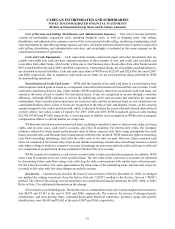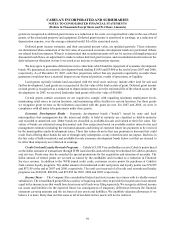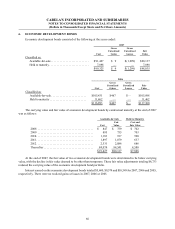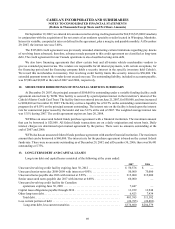Cabela's 2007 Annual Report Download - page 67
Download and view the complete annual report
Please find page 67 of the 2007 Cabela's annual report below. You can navigate through the pages in the report by either clicking on the pages listed below, or by using the keyword search tool below to find specific information within the annual report.
61
CABELA’S INCORPORATED AND SUBSIDIARIES
NOTES TO CONSOLIDATED FINANCIAL STATEMENTS
(Dollars in Thousands Except Share and Per Share Amounts)
2. CHANGE IN ACCOUNTING PRINCIPLES
Inventories:
Effective the beginning of 2007, we changed our method for valuing inventories from the LIFO method to
the FIFO method. Due to merchandise unit cost increases for new and higher-priced product lines we offer, and
because of the market volatility for certain materials in the manufacture of other product lines (primarily firearms
and ammunition), we believe this change was preferable as the FIFO method better reflects our inventory at current
costs. Further, our adoption of the FIFO method enhances the comparability of our consolidated financial statements
by changing to the predominant method utilized in our industry, and reflects the inventory of all of our operations on
the same accounting method. The effect of the change did not have a material impact to our consolidated financial
statements for the years ended 2007, 2006 and 2005. Because the effect of the change on all periods is not material,
no adjustments have been made to our consolidated financial statements to reflect a retrospective application.
At December 30, 2006, $18,697 was included in the current portion of deferred income taxes payable in our
consolidated balance sheet related to the book-tax difference resulting from the LIFO method used for income tax
purposes. Although the use of the LIFO method under income tax regulations requires conformity of methods for
financial reporting purposes, it does allow selection of alternative methods of calculation. Our LIFO calculation for
income tax purposes utilizes a simplified LIFO approach which results in a book-tax difference. The change to the
FIFO method in the first quarter of 2007 increased the current portion of income taxes payable by $4,674 and reduced
the current deferred income tax liability by $4,674. We will incur a cash outlay totaling $18,697 over the next four
years since we elected in our 2007 federal income tax return to change our method of accounting for inventory from
LIFO to FIFO for income tax purposes.
Uncertainty in Income Taxes:
On December 31, 2006, we adopted the provisions of FASB Interpretation No. 48, Accounting for Uncertainty
in Income Taxes – an Interpretation of FASB Statement No. 109 (“FIN 48”). FIN 48 prescribes a recognition threshold
and measurement attribute for the financial statement recognition and measurement of a tax position taken or expected
to be taken in a tax return. The recognition threshold requires that we determine whether it is more likely than not
that a tax position will be sustained upon examination, and then the position is measured at the largest amount of the
benefit that is greater than 50 percent likely of being realized upon ultimate settlement. Unrecognized tax benefits
are tax benefits claimed on our tax returns that do not meet these recognition and measurement standards.
As a result of adopting FIN 48 we recognized additional liabilities for unrecognized tax benefits of $8,569. Of
this amount, $966 after-tax was recorded as a one-time decrease to our beginning retained earnings. The remaining
amount was previously accrued under FAS 5, Accounting for Contingencies, or FAS 109, Accounting for Income
Taxes. In addition, we recorded $1,196 before-tax, or $789 after-tax, of accrued interest on the estimated unrecognized
tax benefits as a one-time decrease to our beginning retained earnings. The cumulative effect of adopting FIN 48
totaled $1,755 as a decrease to our beginning retained earnings.
























